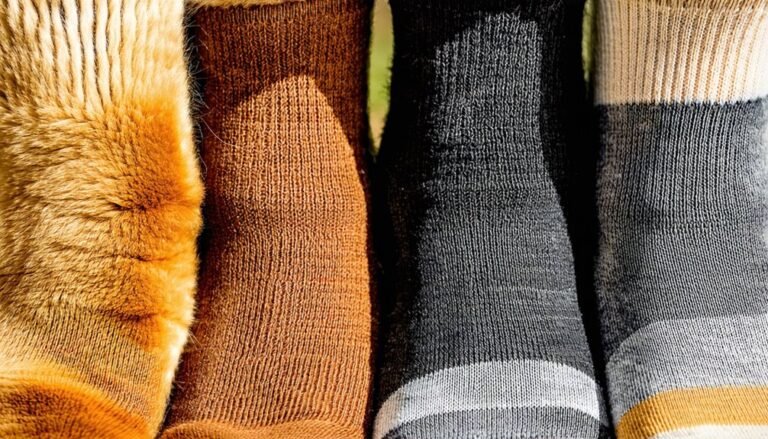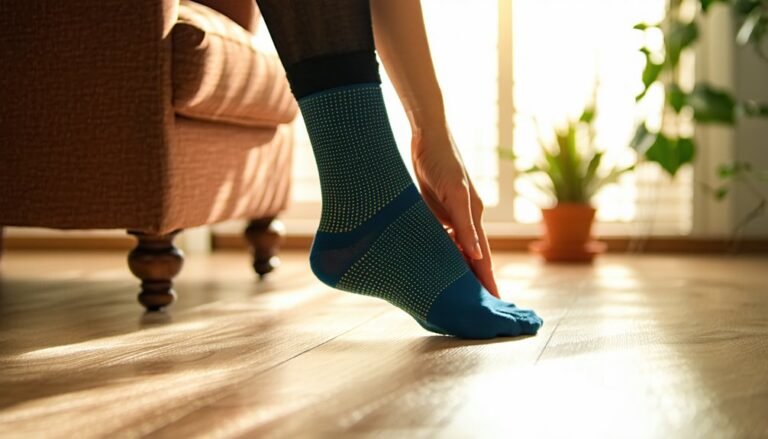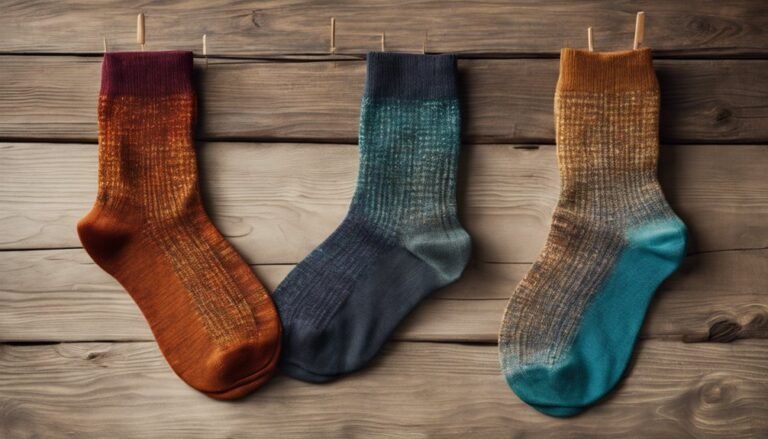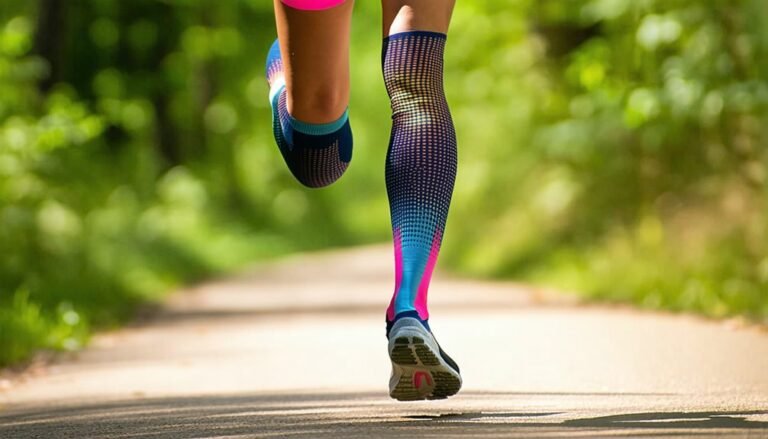Sock Size Vs Shoe Size Men
Your sock selection should rely on shoe size to guarantee ideal foot health, as it directly impacts sock stretch and comfort. Men's shoes often align with sock sizes but prioritize elasticity and material composition for anatomical conformity. An ill-fitting sock can compromise circulation, increase blister risk, and create pressure points. Remember, different activities may require size adjustments for enhanced performance. Explore further to understand how foot shape and measurement techniques refine sock size selection.
Understanding Sock Sizes

Understanding sock sizes involves a precise correlation between foot anatomy and the standard sizing metrics used in the textile industry. When selecting socks, you'll need to take into account both the biomechanical aspects of your foot and the characteristics of the sock materials. Different materials can influence the fit, with elasticity playing a vital role in accommodating foot dimensions safely. Sock patterns are not merely aesthetic; they determine stretch and compression zones, directly impacting comfort and circulation. It's important to select socks that conform to your foot's anatomical structure to prevent issues such as chafing or restricted blood flow. Prioritizing proper fit guarantees that socks perform their intended protective function, maintaining foot health by providing adequate support without compromising safety.
How Shoe Size Influences Sock Fit
When selecting socks, your shoe size plays a pivotal role in ensuring ideal sock stretch and comfort. Proper sizing techniques are essential to accommodate the anatomical contours of the foot, minimizing constriction and enhancing circulation. You'll find that an accurately sized sock reduces friction and supports joint alignment, promoting overall foot health.
Sock Stretch and Comfort
The interaction between shoe size and sock fit is a critical factor affecting both stretch and comfort. When socks stretch inadequately, they compromise sock breathability and moisture management, leading to potential skin irritations. Anatomically, an ill-fitting sock can impede circulation and create pressure points. Consider the table below to understand the relationship between shoe size and sock elasticity:
| Shoe Size | Sock Fit | Potential Outcome |
|---|---|---|
| Small | Tight | Restricted circulation |
| Medium | Ideal | Enhanced comfort |
| Large | Loose | Excessive slipping |
Clinically, a properly fitted sock guarantees ideal moisture management, reducing the risk of fungal infections. Prioritize socks with advanced moisture-wicking materials for safety and comfort. You should aim for a balance between elasticity and fit to maintain anatomical integrity and prevent discomfort.
Proper Sizing Techniques
Balancing sock elasticity and shoe size is imperative for maintaining ideal foot health. When selecting socks, the interplay between shoe size and sock fitting techniques becomes paramount. Accurate measurement tools, like Brannock devices or tape measures, can help determine precise dimensions of your foot. This guarantees socks aren't excessively tight or loose, which can impede circulation or cause friction-related injuries. Anatomically, a snug fit facilitates ideal blood flow and aligns with the natural contour of your foot, reducing the risk of blisters and calluses. Proper sock fitting techniques involve evaluating the stretch and material resilience to accommodate dynamic foot movements. Always guarantee socks complement the shoe's inner dimensions, preventing unnecessary compression or slippage, thereby safeguarding against potential podiatric complications.
The Role of Elasticity in Sock Fit
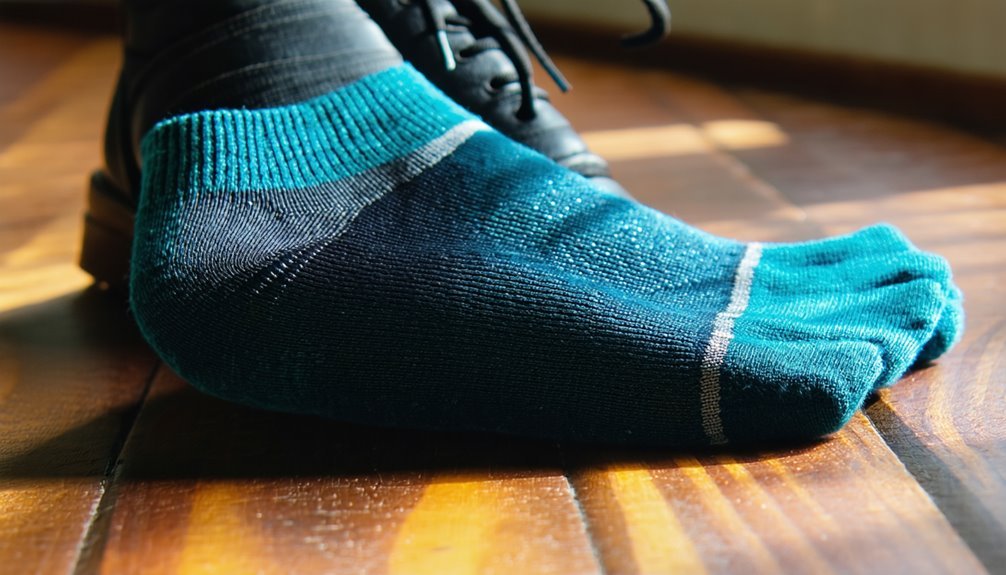
Although often overlooked, elasticity plays an essential role in determining the fit of a sock, directly impacting comfort and performance. Elasticity benefits include adaptability to foot contours, vital for maintaining proper compression around the foot and ankle. Proper compression enhances circulation by applying gentle pressure, promoting venous return and reducing edema risk. This is particularly important for individuals at risk for circulation issues or those engaged in prolonged physical activity. Anatomically, a sock's elasticity guarantees secure placement, reducing friction and minimizing the risk of blisters or abrasions. An ideal elastic fit aligns with the foot's anatomical structures, providing stability without constriction. For maximum safety, choose socks with appropriate elasticity to balance support and comfort, assuring both effective compression and anatomical harmony.
Material Considerations for Sock Sizing
When selecting socks, you should consider the fiber blend as it directly affects elasticity and comfort, influencing how well the sock conforms to the anatomical contours of your foot. A blend that optimizes elasticity can enhance fit and prevent circulation issues, while thickness and durability are critical for long-term wear and protection. Evaluating these material properties guarantees that your sock selection supports foot health and aligns with shoe size compatibility.
Fiber Blend Impact
Understanding the impact of fiber blends on sock sizing is essential for ensuring ideal fit and functionality. Fiber types such as cotton, wool, and synthetics each exhibit unique characteristics affecting moisture management, thermal regulation, and durability. The blend ratios of these fibers directly influence the sock's adaptability to your foot's anatomical structure, impacting circulation and overall comfort. Incorrect fiber blend ratios can lead to ill-fitting socks, causing pressure points or restricted blood flow, which pose potential risks to foot health. Clinically, selecting the appropriate blend ratio is vital for maintaining foot hygiene and preventing conditions like blisters or fungal infections. Always prioritize socks that balance natural and synthetic fibers to maximize both protection and performance while accommodating specific anatomical needs.
Elasticity and Comfort
While selecting the right sock size, considering elasticity is vital for achieving ideal comfort and support. Elasticity benefits are significant for accommodating foot movement and maintaining peak circulation. Socks with appropriate elasticity conform to the foot's anatomical contours, reducing the risk of pressure points and skin abrasions. Comfort factors are enhanced when elasticity allows for controlled expansion and contraction. This guarantees that the sock remains securely in place, preventing slippage or undue constriction. Clinically, selecting socks with the right elasticity can mitigate the risk of blisters and calluses. For safety, prioritize socks that balance elasticity and snugness without compromising blood flow. By focusing on these elements, you secure a fit that promotes foot health and enhances overall comfort in daily activities.
Thickness and Durability
Thickness and durability in sock selection are paramount for guaranteeing long-lasting wear and ideal foot protection. When considering sock thickness, assess the thermal insulation properties and cushioning capabilities, which influence foot comfort and joint pressure distribution. Thicker socks provide enhanced padding, reducing the risk of blisters and calluses, while also offering additional warmth in colder environments.
Sock durability is critical for maintaining structural integrity over extended use. Evaluate fiber composition; synthetic blends often exhibit superior abrasion resistance compared to natural fibers. Reinforced toe and heel areas are essential for preventing premature wear. Selecting socks with high tensile strength fibers ensures longevity, reducing the frequency of replacements. Prioritizing these factors in sock sizing enhances biomechanical stability and safeguards foot health.
Foot Shape and Its Impact on Sock Size
Although often overlooked, the anatomical structure of your foot plays a crucial role in determining the appropriate sock size. Precise sock fitting minimizes discomfort and prevents injuries. Various foot elements, such as foot arch and toe length, impact how socks fit. A high foot arch can cause socks to feel tighter, leading to restricted circulation. Conversely, a low arch might result in excess fabric bunching. Furthermore, toe length variations necessitate different sock lengths for maximum comfort.
To guarantee safety and comfort, consider the following:
- Assess foot arch: High or low, it affects sock tension.
- Measure toe length: Longer toes need additional sock room.
- Monitor fit: Regularly checking sock fit prevents blisters and pressure points.
Tailoring sock size to anatomical nuances promotes healthy feet.
Common Sock Sizing Systems
When evaluating sock sizes, you'll encounter various systems, each with distinct parameters. The US sock sizing system typically correlates with shoe size, which can simplify selection but may not account for anatomical variations like arch height or foot circumference. In contrast, the European standards often require a conversion for accurate fitting, necessitating awareness of the differences to guarantee proper foot health and comfort.
US Sock Sizing System
The US Sock Sizing System is essential for guaranteeing ideal fit and comfort, particularly as ill-fitting socks can lead to discomfort and foot health issues. Proper sock length and sock width are critical in maintaining foot safety and health. Ill-fitting socks can create pressure points, restricting circulation and causing blisters. To prevent these issues:
- Sock Length: Make sure the sock length covers the foot and ankle adequately, avoiding excessive compression or slippage.
- Sock Width: Select socks that accommodate foot girth without constriction, promoting optimal circulation.
- Material Composition: Choose breathable materials to prevent moisture accumulation and reduce infection risk.
Guaranteeing your socks fit within these parameters will enhance comfort and protect your feet, contributing to overall foot well-being in a clinical context.
European Sock Standards
European sock standards are essential for guaranteeing socks fit well within the varied shoe size ranges across the continent. When considering these standards, European sizing focuses on both sock length and foot dimensions. This system guarantees compatibility with the anatomical structure of the foot, promoting comfort and reducing injury risk. The European sizing approach utilizes specific numerical ranges that correspond to foot length, measured in centimeters. This precision allows for a superior fit that accommodates the natural contours of the foot. The sock length plays a critical role, guaranteeing adequate coverage and support, which enhances blood circulation and reduces friction-related injuries. By adhering to these standards, you maintain foot health and stability, aligning with safety protocols that protect your anatomical integrity.
Conversion Between Systems
Maneuvering the conversion between common sock sizing systems can be essential for ensuring an ideal fit and maintaining foot health. Proper sock selection supports anatomical structures, enhancing comfort and preventing injury. Sock sizing comparisons can seem complex, but understanding them is critical for aligning with shoe fitting guidelines.
Here are three key points for effective conversion:
- Understand Sizing Scales: Sock sizes often correspond to shoe sizes. Recognize the numeric difference between systems, such as US, UK, and European standards.
- Consider Material Stretch: Socks made with elastic fibers may accommodate a range of sizes, but proper fit is important to avoid constriction or slippage.
- Prioritize Health and Comfort: Ill-fitting socks can lead to blisters or impede circulation, so precise sizing is essential for safety.
Measuring Your Foot for the Perfect Sock Fit
Accurate foot measurement is vital for selecting properly fitting socks. Begin by employing precise foot measurement techniques to guarantee the ideal sock length. Use a measuring tape to gauge the foot's length from heel to longest toe, and the circumference at the widest part. These dimensions are essential for sock fit, preventing undue pressure or slippage.
| Measurement | Foot Dimension | Sock Implication |
|---|---|---|
| Length | Heel to Toe | Determines size |
| Circumference | Ball of Foot | Guarantees comfort |
| Arch Height | Mid-foot arch | Supports fit |
From a clinical perspective, these measurements guarantee safety by reducing risks of blisters, circulation issues, or discomfort. Properly fitted socks contribute to overall foot health, offering stability and cushioning where necessary. Prioritize these foot anatomy insights for ideal sock selection.
Tips for Selecting the Right Sock Size
Choosing the right sock size is essential for guaranteeing ideal comfort and foot health. Ill-fitting socks can lead to compromised circulation, friction-induced blisters, and pressure sores. To mitigate such risks, consider the following:
- Analyze Sock Materials: Opt for breathable, moisture-wicking fabrics like merino wool or synthetic blends. These materials regulate temperature and reduce microbial growth, promoting foot safety.
- Evaluate Sock Styles: Different activities necessitate specific sock styles. Compression socks, for instance, provide graduated pressure, enhancing venous return and reducing edema.
- Consult Sizing Charts: Manufacturer-specific sizing charts align sock dimensions with foot length and girth. Accurate sizing guarantees anatomical alignment, minimizing stress on foot structures.
Importance of Trying on Socks Before Buying
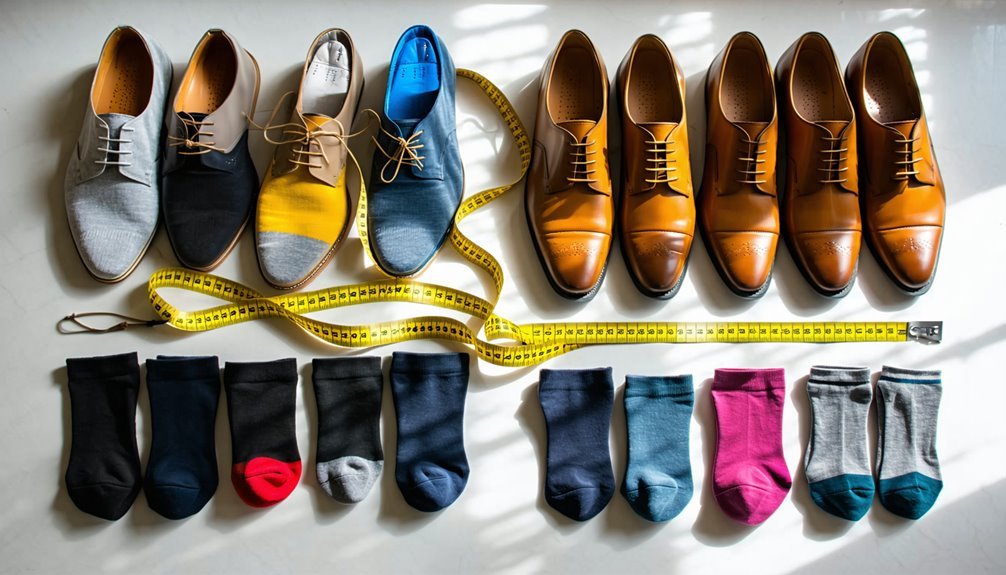
While often overlooked, trying on socks before purchasing is essential for guaranteeing ideal fit and function. This practice safeguards against discomfort and potential foot issues. Anatomically, sock comfort is influenced by the sock's ability to conform to your foot's unique structure. Various fabric types can affect this, impacting moisture wicking, elasticity, and thermal regulation. Each foot is distinct, necessitating a personalized evaluation to optimize fit and safety. Consider the following elements:
| Factor | Importance |
|---|---|
| Fabric Types | Affects breathability and moisture control |
| Sock Size | Determines proper alignment with foot anatomy |
| Elasticity | Guarantees snug fit without constriction |
| Seam Placement | Prevents friction and irritation |
Adjusting Sock Size for Different Activities
When engaging in different activities, adjusting your sock size can enhance performance and comfort by accommodating variations in foot dynamics and pressure distribution. Activity specific socks are designed to meet the physiological demands of distinct motions. Choosing the right size is vital for preventing injuries and optimizing support. For example, athletic performance socks must fit snugly to avoid blisters and guarantee efficient moisture wicking.
Consider these factors when selecting socks:
- Arch Support: Proper fit aids in distributing pressure evenly, reducing strain on the plantar fascia.
- Cushioning: Enhanced padding in targeted areas helps absorb shock during high-impact activities, like running.
- Compression: Graduated compression promotes venous return and reduces muscle fatigue, essential for endurance sports.
Prioritize safety by selecting the appropriate sock size for your specific activities.
Frequently Asked Questions
How Do Sock Sizes Vary Across Different Brands?
When evaluating sock brand comparisons, you'll notice variations due to disparate sizing standards. Each brand's anatomical focus can impact fit, so it's essential to guarantee compatibility for ideal circulation and comfort, prioritizing foot health and preventing potential injuries.
Can Shoe Size Accurately Predict Sock Size for Online Purchases?
You can't always rely on shoe sizes to predict sock fitting accurately. Sizing guidelines differ per brand, affecting fit. Anatomically, socks should accommodate foot width and arch, ensuring safety and comfort without constricting blood flow or causing discomfort.
Do Different Sock Types Require Different Sizes?
When choosing socks, one's foot is like a delicate instrument requiring precise calibration. Different sock types, with varying thickness and material impact, necessitate tailored sizing to guarantee ideal fit, comfort, and prevent circulation issues or friction injuries.
How Does Sock Shrinkage Affect Size Over Time?
You're concerned about sock shrinkage over time? Sock material greatly impacts shrinkage factors. Cotton tends to shrink more than synthetic fibers. Anatomically, this can constrict foot movement, risking circulation issues. Choose materials wisely for safety and comfort.
Are There Universal Sock Sizes for Men Internationally?
Isn't it fascinating how sock size standards aren't universally aligned with international sizing? Anatomically speaking, ensuring proper fit is essential for foot health, minimizing risks of blisters or circulation issues, and promoting ideal comfort across different regions.


